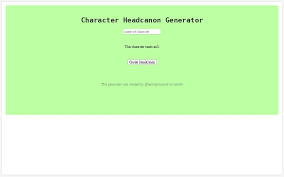Explore the Character Backstory
Origins and headcanons should always are based on the canon life of the subject at its most basic thinking. Examine their motives, who they are, what kind of history they have, their relationships and character traits that they portrayed in their particular media. So, in the same way, by using his headcanon for character like Batman should think of his complex psychology and traumatic past which affect his following steps and decisions. In digging up these sorts of details, fans can build off of established narratives in manners that respect the character, but also introduce them in new dimensions.
Find the 'What If?' and Untold Stories Scenarios
The best way to create one is to ask the question:... and develop them by way of the numerous 'what if?''s characters operating outside their established world(s) Pose questions such as: What if this character had taken an alternate course at an important plot twist? or "But what if they had been raised in a different family?" Such questions can lead to a wealth of unique and compelling answers. Take the case of a character from a dystopian book which if imagined in a utopian space may undergo a complete transformation in personality and its course in life.

However, you got a little help in that you were able to combine characters with their contexts and re-construct the merge conflict.
Headcanons can be beautiful things where you mix characters from one story with the context or setting of another. One method that can be effective is to transplant a character into a different story or even genre and brainstorm how they would fit if transposed. So, for example, dropping a Sherlock Holmes character into the futuristic Blade Runner world (hint hint, agents, it has not been done) might show new dimensions of his detection techniques and moral judgments when applied to a high-tech society.
Get Into The Minds and Hearts Disabled Characters
It you would like to make a character more 3-dimensional, it's perfectly fine to add layers by giving them depth and adding a touch of intricate, relatable psychological or emotional dimensions that are faithful to the canons but with a new twist. Think about their fears, secret desires, or unfinished businesses. A well-supported emotional landscape enables one to provide profoundly resonant headcanons with the audience. You might imagine a character experiencing grief or recovery from a loss, which can lead to narratives on resilience and change.
Engage with Fan Communities
Fan Communities - Engaging with Fan Communities can give a better understanding of what headcanons to want to create. These communities often create a sharing of knowledge that can lead to new ways of thinking and potentially make a character even better on the list. Talking with other fans can be valuable to work out headcanons, making sure they stay creative and still follow ok rules with the actual material.
Use Tools Such as the Character Headcanon Creator
The character headcanon creator is an attempt to help those who are searching for structured guidance with this part of RP, rather than presenting it as something that everyone should do if they RP at all. The reason I like these tools is they provide the specifics and ideas which can get fans to start thinking this way. By offering a variety of random elements to contemplate, they generate fresh and unpredictable headcanons that serve to enrich the creative process, as well as providing more ways for audiences to relate with their favorite characters.
Coming up with headcanons of our favourite well-known characters is our way of participating in the stories we love, keeping them alive and improving our emotional bond to who they are as characters. However, through their own imaginative explorations of character motivations and new situations, fans can create the kind of fan content that keeps a fandom alive while also being part of the larger tapestry of the community narrative by supporting and extending its life of their headcanons.
